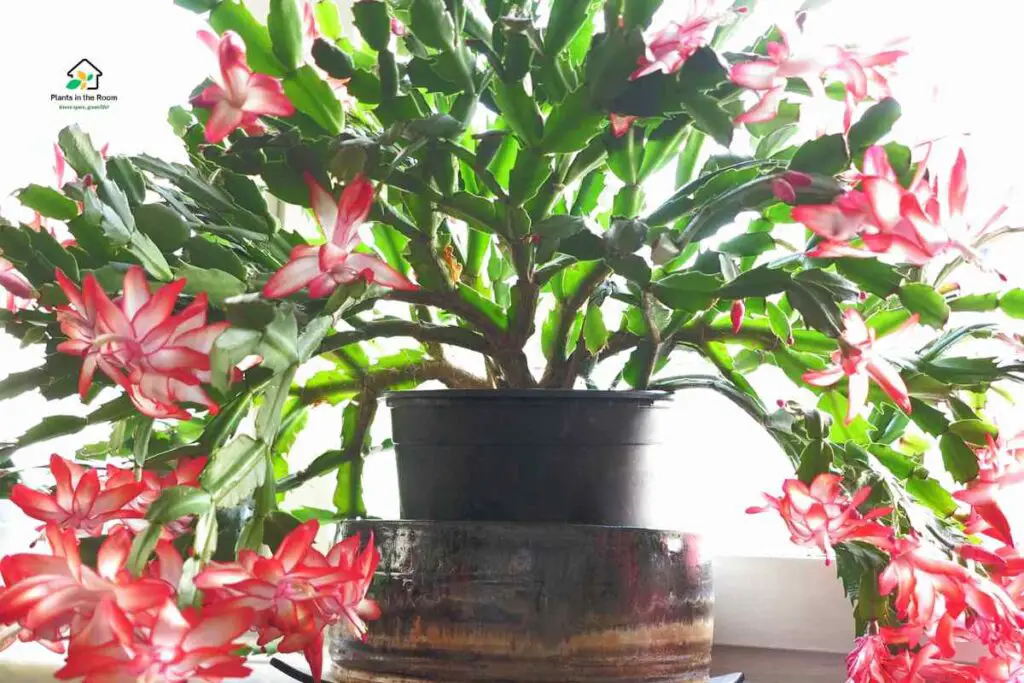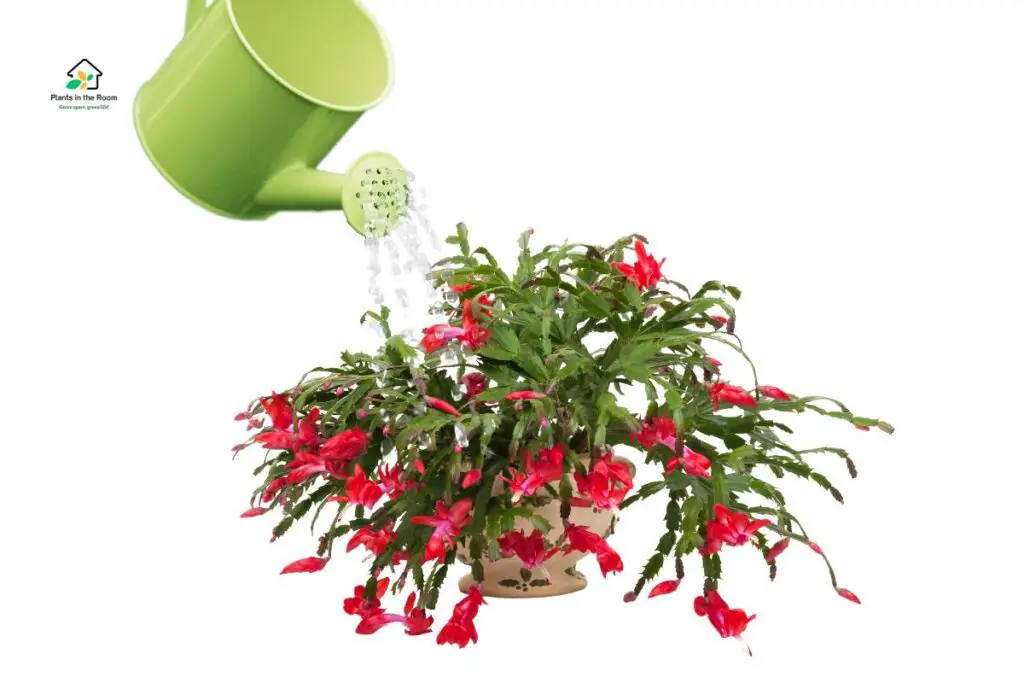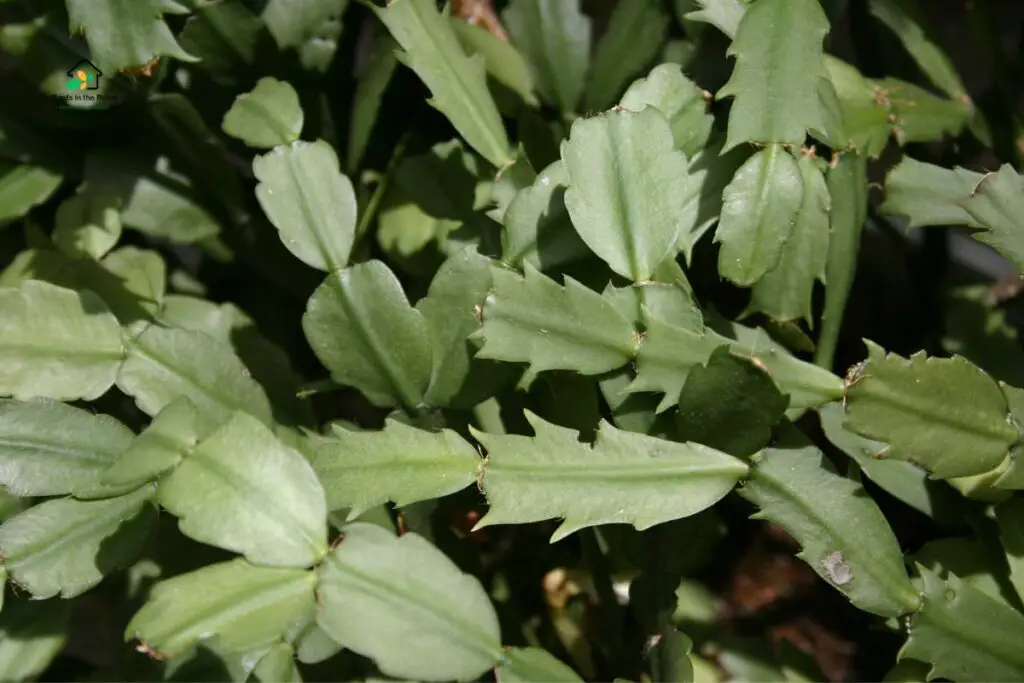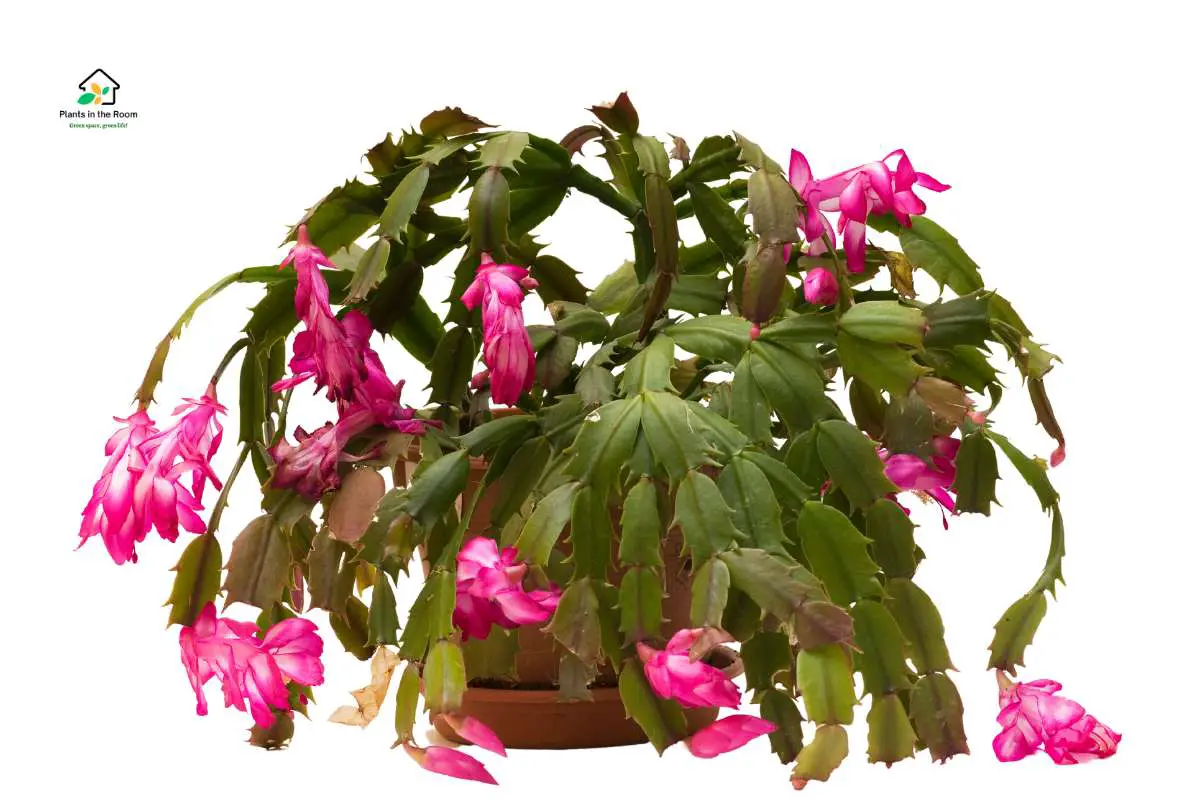This article covers the following areas –
- Understanding the Christmas Cactus
- Choosing the Right Variety
- Providing the Ideal Light Conditions
- Creating the Perfect Potting Mix
- Watering Techniques
- Maintaining Optimal Temperature and Humidity
- Fertilizing for Optimal Growth and Blooming
- Pruning and Propagating Your Christmas Cactus
- Preventing and Treating Pests and Diseases
- Encouraging a Regular Blooming Cycle
- In Conclusion
- Get to Know Your Christmas Cactus
The Christmas Cactus (Schlumbergera) is a popular, low-maintenance houseplant that adds a burst of color to your home during the holiday season. Its eye-catching, tubular flowers and unusual, segmented foliage make it an attractive addition to any houseplant collection. In this post, I’ll cover all aspects of Christmas Cactus care, helping you nurture a healthy, vibrant plant.
Christmas Cactus care involves bright indirect light, moderate watering, high humidity, well-draining soil, and balanced fertilization every 2-4 weeks during the growing season. Allow soil to partially dry between waterings and maintain high humidity for optimal growth.
Now, let me share my experience and give you some tips in detail to help you ensure the best care for your Christmas Cactus care.
Understanding the Christmas Cactus

To provide the best care for your Christmas Cactus, it’s essential to understand its natural habitat and growth habits. These epiphytic cacti are native to the cloud forests of Brazil, where they grow on trees and rocks in a moist, humid environment. Unlike desert cacti, Christmas Cacti have adapted to thrive in areas with less intense sunlight and more frequent rainfall.
Knowing the plant’s natural habitat helps you replicate these conditions in your home, ensuring the health and happiness of your Christmas Cactus.
Choosing the Right Variety
The Schlumbergera genus comprises several species and hybrids, each with its distinctive characteristics. When selecting a Christmas Cactus, it’s crucial to consider factors such as flower color, mature size, and overall plant shape. Additionally, it’s essential to choose a variety that will thrive in the specific growing conditions available in your home, such as light levels, humidity, and temperature.
1. Flower Color
Christmas Cacti are known for their vibrant tubular flowers that bloom during the holiday season. Some of the most common species found in cultivation are S. bridgesii, S. truncata, and S. russelliana. These species come in numerous cultivars with various flower colors, including pink, red, white, and orange. When selecting a variety, consider your personal preferences and how the flower color will complement your existing decor or other plants.
2. Mature Size
Christmas Cactus plants typically grow to a height of 1-2 feet, making them suitable for a range of indoor spaces. However, some hybrids or cultivars may vary in size, so it’s essential to choose a variety that suits the space where you plan to place the plant. Consider factors such as available floor or shelf space, ceiling height, and the desired visual impact of the plant within your home.
3. Overall Plant Shape
Christmas Cacti have a unique growth habit, characterized by their flat, segmented foliage that drapes gracefully from the pot. While all Schlumbergera species share this general growth pattern, some cultivars may exhibit subtle differences in foliage shape or branching structure. Consider the overall plant shape when choosing a variety, as it will affect the plant’s appearance and how it fits within your interior design.
4. Growing Conditions
It’s important to select a Christmas Cactus variety that will thrive in the specific growing conditions available in your home. While all Schlumbergera species have similar care requirements, some cultivars may be more tolerant of varying light levels, humidity, or temperature fluctuations. Research the specific needs of your chosen variety and ensure that your home can provide the necessary conditions for the plant to thrive.
Providing the Ideal Light Conditions
Christmas Cacti thrive in bright, indirect light, which mimics the dappled sunlight they receive beneath the forest canopy. Place your plant near an east or north-facing window, where it will receive consistent, filtered light throughout the day. This ensures your cactus gets enough light to support healthy growth and flowering without the risk of scorching its delicate leaves.
If you don’t have access to a suitable window, you can also use artificial lighting, such as fluorescent or LED grow lights, to provide your plant with the necessary light levels. Monitor your plant’s growth and adjust the light levels as needed, looking for signs of stretching or thinning growth, which may indicate a need for more light.
Creating the Perfect Potting Mix
A well-draining potting mix is crucial for the health of your Christmas Cactus. These plants require a soil that retains moisture but also allows excess water to drain quickly, preventing root rot. An ideal potting mix for Christmas Cacti combines equal parts of regular potting soil, perlite, and coarse orchid bark. This blend will ensure proper drainage, aeration, and moisture retention.
When repotting your Christmas Cactus, choose a container with drainage holes to prevent standing water in the pot. It’s also a good idea to repot your plant every 2-3 years or when it becomes root-bound, which allows for better nutrient absorption and overall plant health.
Watering Techniques

Finding the right balance between consistent moisture and proper drainage is key to a thriving Christmas Cactus. Allow the top inch of the soil to dry out between waterings, and then water the plant thoroughly, ensuring the water drains from the bottom of the pot. This approach prevents overwatering and the risk of root rot while still providing the moisture your plant needs.
During the growing season (spring and summer), you may need to water your Christmas Cactus more frequently, as the plant will be actively growing and using more water. In contrast, during the dormant period (fall and winter), reduce your watering frequency, as the plant’s growth slows down and its water requirements decrease.
Always monitor your plant’s condition and adjust your watering schedule accordingly, keeping an eye out for signs of overwatering (yellowing or wilting leaves) or underwatering (wrinkled or shriveled leaves).
Maintaining Optimal Temperature and Humidity
Christmas Cacti thrive in temperatures between 60-80°F (16-27°C) and high humidity levels, similar to their natural habitat. To increase humidity around your plant, you can place it on a tray filled with water and pebbles, ensuring the pot sits above the waterline to prevent root rot.
You can also mist your plant regularly or use a humidifier to maintain the desired humidity levels.
During the fall, as the days get shorter and the temperatures begin to drop, your Christmas Cactus will enter its blooming cycle. To encourage the formation of flower buds, expose your plant to cooler nighttime temperatures, ideally between 55-60°F (13-16°C).
However, avoid exposing your plant to temperatures below 50°F (10°C), as this may cause damage to the foliage and disrupt the blooming process.
Fertilizing for Optimal Growth and Blooming
Feeding your Christmas Cactus with a balanced, water-soluble fertilizer every 4-6 weeks during the growing season will promote healthy growth and encourage abundant blooming.
Choose a fertilizer with equal amounts of nitrogen, phosphorus, and potassium (such as a 10-10-10 or 20-20-20 formula) and follow the package instructions for the appropriate application rate.
It’s important to stop fertilizing your plant during the dormant period (fall and winter), as it will not be actively growing and won’t require additional nutrients. Resume fertilizing in the spring when new growth appears.
Pruning and Propagating Your Christmas Cactus
Pruning your Christmas Cactus helps maintain its shape and size, promotes bushier growth, and removes any dead or damaged segments. Use clean, sharp scissors or pruners to remove segments at the joint where they connect. The best time to prune is after the blooming period, typically in late winter or early spring.
Christmas Cactus propagation is an easy and rewarding process. After pruning, allow the cuttings to dry for a day or two, forming a callus on the cut end. Then, insert the callused end into a small pot filled with the same well-draining potting mix used for the parent plant.
Keep the potting mix slightly moist and place the pot in a bright spot with indirect light. In a few weeks, new roots and growth should appear, signaling a successful propagation.
Preventing and Treating Pests and Diseases

Christmas Cacti can occasionally suffer from pests such as mealybugs, spider mites, and fungus gnats, as well as diseases like root rot and stem rot. To prevent these issues, inspect your plant regularly, maintain proper watering and light conditions, and isolate any affected plants to prevent the spread of pests or diseases.
In case of an infestation, treat your plant with insecticidal soap or neem oil, following the package instructions. For diseases like root rot or stem rot, remove the affected parts, improve the plant’s growing conditions, and consider repotting in fresh, well-draining soil.
Encouraging a Regular Blooming Cycle
One of the most rewarding aspects of growing a Christmas Cactus is its prolific blooming. However, sometimes these plants can be a bit finicky about producing flowers. To encourage a regular blooming cycle, pay close attention to light exposure and temperature fluctuations in the weeks leading up to the expected bloom time.
Starting in early fall, ensure your Christmas Cactus receives about 12-14 hours of darkness per day for 6-8 weeks. This can be achieved by placing it in a room that gets minimal artificial light at night or covering it with a light-blocking cloth in the evenings. Simultaneously, expose your plant to cooler nighttime temperatures, as previously mentioned, to further stimulate bud formation.
Once you see flower buds forming on your Christmas Cactus, resume your regular light schedule and maintain consistent temperatures to support the blooming process.
In Conclusion
Caring for a Christmas Cactus can be a rewarding and fulfilling experience, as your efforts are rewarded with vibrant blooms and healthy growth. By understanding your plant’s specific needs and providing the appropriate care, you can enjoy a thriving Christmas Cactus for many years to come.
Follow the tips and advice in this comprehensive guide to ensure your plant remains healthy and vibrant, gracing your home with its stunning flowers each holiday season.
Get to Know Your Christmas Cactus
| Indicator | Christmas Cactus |
|---|---|
| Family | Cactaceae |
| Genus | Schlumbergera |
| Species | S. bridgesii, S. truncata, S. russelliana |
| Common Name | Christmas Cactus |
| Origin | Brazil (Cloud forests) |
| Plant Type | Perennial, Epiphytic cactus, Indoor plant |
| Mature Size | 1-2 feet in height |
| Growth Rate | Moderate |
| Light Requirements | Bright, indirect sunlight |
| Watering Requirements | Moderate, allow soil to partially dry out |
| Soil Preference | Fast-draining soil, such as a mix of potting mix, perlite, and coarse orchid bark |
| pH Preference | 5.5-6.5 (Slightly acidic) |
| Temperature Tolerance | 60-80°F (16-27°C) |
| Humidity Tolerance | High humidity, around 50% or higher |
| Fertilization | Balanced fertilizer every 2-4 weeks during the growing season |
| Propagation | Stem cuttings |
| Pests | Mealybugs, fungus gnats |
| Diseases | Root rot, stem rot |
| Toxicity | Non-toxic to humans and pets |
| Special Features | Attractive segmented foliage, vibrant tubular flowers |
| Popular Uses | Indoor houseplant, hanging baskets, windowsills |
We hope you found this information helpful! Please feel free to share your thoughts, experiences, and tips on Christmas Cactus care in the comment box below. We’d love to hear from you and learn from your insights!






